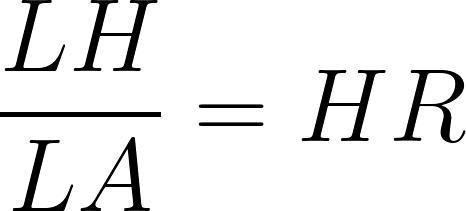For all our perceived modernity, the tangible mechanics and philosophies behind music writing remain blissfully traditionalist. We aren’t Hector Berlioz, we aren’t deconstructing symphonies, we’re writing about how pop songs make us feel. That’s okay, pop songs exist for us to feel them, but when you consider how something like sportswriting has slowly moved towards hardline statistical analysis from simple newspaper profiles, our music-crit processes can look a little shaky. Maybe this is because I’ve been reading a lot of old Fire Joe Morgan posts lately, but what if there was a sabermetric set of advanced-analytics to evaluate music on a true, mathematical level? Wouldn’t that be the right thing to do? And who better to design these formulas than a 22-year old History major? Please, allow me to kick us into the next era of music writing.Hook Ratio Where: LH = Length of Combined Hooks, LA = Length of Album, HR = Hook RatioThe Hook Ratio is a numerical representation of the density and percentage of an album that is hook-based, as opposed to filler-based. We simply add up the time of all an album’s hooks, and divide by the overall length of an album. Comparatively, this should show what albums are most efficient at rocking your shit. I think if you put the new Disclosure album into this formula, it would come out as a perfect one.Old World Bias Quotient
Where: LH = Length of Combined Hooks, LA = Length of Album, HR = Hook RatioThe Hook Ratio is a numerical representation of the density and percentage of an album that is hook-based, as opposed to filler-based. We simply add up the time of all an album’s hooks, and divide by the overall length of an album. Comparatively, this should show what albums are most efficient at rocking your shit. I think if you put the new Disclosure album into this formula, it would come out as a perfect one.Old World Bias Quotient Where: PR = Pitchfork Rating, RS = Rolling Stone Rating, NS = Number of Synthesizers, NMC = Number of ‘Musicianship’ Claims in Review Text, OWB = Old World Bias QuotientI’m sure these are all comparable integers. Once we find the difference between the Pitchfork review score and the Rolling Stone review score, it can easily be compared with the synthesizer presence, as well as foggy old-man talk about why laptops aren’t instruments. The Old World Bias Quotient is especially crucial when reading David Fricke.Perceived Social Political Weight Proportionality
Where: PR = Pitchfork Rating, RS = Rolling Stone Rating, NS = Number of Synthesizers, NMC = Number of ‘Musicianship’ Claims in Review Text, OWB = Old World Bias QuotientI’m sure these are all comparable integers. Once we find the difference between the Pitchfork review score and the Rolling Stone review score, it can easily be compared with the synthesizer presence, as well as foggy old-man talk about why laptops aren’t instruments. The Old World Bias Quotient is especially crucial when reading David Fricke.Perceived Social Political Weight Proportionality Where: IQ = Socially-charged Interview Quotes, IL = Socially-charged Intelligible Lyrics, AAR = Album Art Relevance, PSPW = Perceived Social Political Weight.Sometimes it’s hard to tell exactly how political an artist’s “political” album is. Just how much does Shaking the Habitual have to do with gender issues? Luckily with our handy-dandy formula, you can tell if you’ll look like an idiot if you call Titus Andronicus “revolutionary.”Feminist Buzz Range
Where: IQ = Socially-charged Interview Quotes, IL = Socially-charged Intelligible Lyrics, AAR = Album Art Relevance, PSPW = Perceived Social Political Weight.Sometimes it’s hard to tell exactly how political an artist’s “political” album is. Just how much does Shaking the Habitual have to do with gender issues? Luckily with our handy-dandy formula, you can tell if you’ll look like an idiot if you call Titus Andronicus “revolutionary.”Feminist Buzz Range Where: BT = Blog Traction, PTT = Pelly Twin Tweets, DMT = Devon Maloney Tweets, JHT = Jessica Hopper Tweets, MJT = Maura Johnston Tweets, FBR = Feminist Buzz Range.Want to know how relevant Waxahatchee is on a specific scale? Don’t worry! With our state of the art equation, we utilize several important voices to get a snapshot of what you should be listening to in order to stay invulnerable on Twitter.Too Old For This Constant
Where: BT = Blog Traction, PTT = Pelly Twin Tweets, DMT = Devon Maloney Tweets, JHT = Jessica Hopper Tweets, MJT = Maura Johnston Tweets, FBR = Feminist Buzz Range.Want to know how relevant Waxahatchee is on a specific scale? Don’t worry! With our state of the art equation, we utilize several important voices to get a snapshot of what you should be listening to in order to stay invulnerable on Twitter.Too Old For This Constant Where: WL = Whiny Lyrics, TM = Tumblr Mentions, A = Your Age, TOTC = Too Old For This ConstantSometimes it’s hard to know if you can wear a Pedro the Lion shirt in public. This is a problem that faces thousands of indie-bros every day. By finding the Too Old for This Constant for a band, you can easily determine if it’s worth the risk. Make sure you don’t put Neutral Milk Hotel in this formula if you’re over the age of 16, as it’s the equivalent of dividing by zero.Is It “Get Lucky?”
Where: WL = Whiny Lyrics, TM = Tumblr Mentions, A = Your Age, TOTC = Too Old For This ConstantSometimes it’s hard to know if you can wear a Pedro the Lion shirt in public. This is a problem that faces thousands of indie-bros every day. By finding the Too Old for This Constant for a band, you can easily determine if it’s worth the risk. Make sure you don’t put Neutral Milk Hotel in this formula if you’re over the age of 16, as it’s the equivalent of dividing by zero.Is It “Get Lucky?” Where: P = Pharrell, AGL = Awesome Guitar Line, GUS = Gloriously Un-Self-Aware SchmaltzHooray! Now you can always know if the song you are listening to is “Get Lucky.”Luke Winkie is 10110 years old in binary. He's on Twitter - @luke_winkie
Where: P = Pharrell, AGL = Awesome Guitar Line, GUS = Gloriously Un-Self-Aware SchmaltzHooray! Now you can always know if the song you are listening to is “Get Lucky.”Luke Winkie is 10110 years old in binary. He's on Twitter - @luke_winkie
Advertisement
Advertisement
